- What Is Body Contouring After Major Weight Loss?
- Post Weight Loss Body Contouring Candidates
- Post Weight Loss Body Contouring Procedures
- Post Weight Loss Body Contouring and Insurance
What Is Body Contouring After Major Weight Loss?
Body contouring after major weight loss typically involves surgical procedures designed to remove excess skin and fat in specific areas of the body, refine shape, and enhance skin firmness. After substantial weight loss, many individuals are affected by excess skin that cannot conform to the reduced body size due to lost elasticity. These contouring surgeries can generally help enhance a patient’s appearance, comfort, and self-confidence, and are custom-tailored to one’s particular needs. They can be advantageous following the use of weight loss injectables and are often performed in areas such as the abdomen, breasts, and lower body. During a consultation with our qualified board-certified plastic surgeon, Neil J. Zemmel, MD, patients can discuss their aesthetic goals and available treatment options for achieving a smoother, more natural body contour.
Am I a Candidate for Post Weight Loss Body Contouring?
There are a number of factors that can contribute to a successful transformation following weight loss. During your initial consultation, your surgeon will perform a complete history and physical to assess your candidacy for after-weight loss body contouring surgery. To evaluate these factors, a number of questions need to be answered:
- How did you lose weight?
- How much weight did you lose and over what time period?
- How long have you been at your current weight?
- Are you at your goal weight?
- If not, how close are you?
- What medical problems did you have before losing weight?
- Do they persist and, if so, are they improved?
- What are your activity levels?
- Do you smoke?
- What fitness activities are you involved with?
- What kind of support system do you have?
- What is your overall nutritional status like?
- What corrections to your body shape would you like to make?
- What physical difficulties or symptoms associated with your body shape do you have?
- How do you expect to look after surgical recontouring?
- Will you accept potentially visible scars in order to achieve improved shape?
Ideal candidates for body contouring have usually reached or are relatively close to their ideal weight and have maintained it for at least six months. They have adopted a lifestyle that includes good nutrition and regular exercise/activity. They are “in a good place” psychologically, and have realistic expectations for their surgical outcomes.
A comprehensive evaluation by Dr. Zemmel, who is experienced in body reshaping following major weight loss, is the best way to determine if you are ready to take the next step in your weight loss journey.
What Are the Different Types of Procedures After Weight Loss?
Arm Lift
One of the most common changes that occurs following major weight loss is significant laxity of the arms. Most often it is characterized by skin laxity that “hangs” off of the upper arm when the arms are raised level to the shoulder. A brachioplasty, also known as an arm lift or upper arm lift, is designed to address laxity of the upper arm that typically accompanies major weight loss.
Because of this severe laxity and hanging skin, many patients feel self-conscious wearing short sleeves and also feel limited in their physical activities. Although exercise can improve underlying muscle tone and strength, the loss of elasticity of the skin and soft tissue covering the muscle obscures any improvements in muscle tone and definition. For most patients, surgical correction is the best way to achieve a tighter, slimmer, more contoured arm.
In this procedure, a pattern of incisions is designed in a manner in which the excess skin is removed, and the overall skin envelope is tightened. In some situations, the incisions can be hidden in the crease of the underarm. However, in most cases, recontouring is achieved by an incision that parallels the groove on the inner aspect of the upper arm parallel or just below the groove adjacent to the bicep muscle. It is important for patients to understand that although all attempts can be made to minimize the scar, it is often visible with short sleeve shirts or sleeveless garments.
Healthy patients who are troubled by loose skin of the upper arm may be candidates for a brachioplasty. Many patients have undergone significant weight loss and have been able to maintain their lower weight for at least six months. To minimize the risk of potential complications, patients should not be active smokers for at least six weeks prior to and following surgery. Patients also must be in good medical condition without significant cardiovascular, pulmonary, or renal disease.
Dr. Zemmel performs brachioplasty arm lift surgery in the hospital setting. This ensures that your surgery takes place in the safest, most reliable medical setting available. Your surgery will be performed in the main operating rooms of a Richmond area hospital. You will also be admitted overnight for pain control and hydration. Dr. Zemmel finds that patients are more comfortable and heal better when they are kept overnight.
Immediately before surgery, Dr. Zemmel will design the operation. The areas of excess upper arm skin are identified, and a pattern of incisions is marked to encompass this tissue. The incisions are usually placed so that the final scars are positioned below the groove of the bicep muscle along the inner arm or along the underside of the arm. The incisions typically run from the underarm to the elbow. Occasionally, the incision will be extended into the underarm if necessary. In patients with significant subcutaneous fat of the upper arm, liposuction can be performed prior to skin excision.
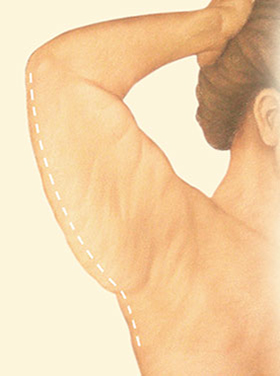
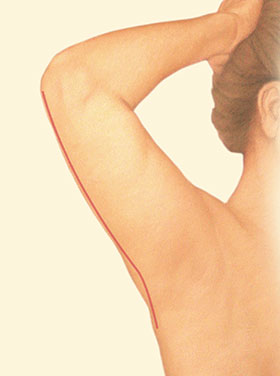
On the morning of surgery, you will meet with our team, who will answer any final question you may have. You will also meet with a board-certified anesthesiologist and nurse anesthetist. Please inform them if you have had any difficulties with anesthesia in the past. You will meet our experienced intraoperative nursing staff who will care for you during surgery. After pre-surgical markings are performed, you will be taken back to the operating room for surgery. Surgery is then performed under general anesthesia and usually takes 90 minutes to two hours. The incisions are made and excess skin and fatty tissue are removed. The incisions are closed using all absorbable sutures so there are no long lines of stitches to remove after surgery. In most cases a drain tube is placed under the skin. The drain is typically removed five days after surgery in the office. You will be given complete instructions on wound care, drain care, and your overall activity restrictions. Occasionally a brachioplasty is performed at the same time as other body shaping procedures such as breast enhancement or tummy tuck surgery. In this case, surgery may take longer.
After surgery, you will notice that your arms will be wrapped in a light compression dressing. Soft drainage tubes are often placed deep to the incisions to collect any fluid that may accumulate after surgery. Your nurses will show you how to care for these drains. They are usually removed five days after surgery, depending on how much fluid is draining. You might notice some post-operative swelling and bruising that usually resolves within one to two weeks. Within the first two weeks following surgery, you will likely be placed in a compression garment of a spandex-like material, to assist in reduction of the swelling and in the recontouring of the arms. Your newly reshaped arm contours typically become more evident as the swelling and bruising subsides. In most cases, you will see noticeable improvements within the first few weeks from surgery. In some cases, it may take up to three to six months to appreciate your new look.
Complications from brachioplasty may include bleeding, infection, long-term scarring, asymmetries, and wound healing complications. Fortunately, all of these occur rarely. Occasionally, patients may develop fluid collections, called seromas, under the incisions that accumulate even after the drains are removed. In most cases, these fluid collections can be drained with a simple office procedure. Some patients will develop numbness along the inner aspect of the upper arm. This numbness usually resolves within approximately six months of surgery; however, in rare cases, it can be permanent.
Breast Lift
Breast lift surgery, or mastopexy, is a cosmetic procedure aimed at raising and firming the breasts by removing excess skin and tightening the surrounding tissue to reshape and support the new breast contour. The need for this surgery often arises from changes in the breasts due to weight fluctuations, aging, childbirth, and breastfeeding, which can cause the breasts to lose their elasticity and sag. During this procedure, incisions are typically created around the areola, down the breast, and sometimes along the breast crease, allowing our surgeon to remove excess skin and lift the breast tissue. Nipples may also be repositioned to a more youthful height. Recovery can vary, but generally involves a few weeks of limited activity so the treatment areas can properly heal.
Panniculectomy
A panniculectomy is a surgical procedure designed to remove the pannus—an excess layer of skin and fat that hangs over the pubic area and lower abdomen, which sometimes occurs after significant weight loss or following pregnancy. Unlike a tummy tuck, which tightens abdominal muscles and improves the contour of the belly, a panniculectomy solely focuses on removing the overhanging skin to relieve associated issues such as hygiene problems, skin irritation, and infections. It is often considered a medically necessary treatment rather than a cosmetic procedure since the goal is to improve mobility, reduce health risks, and enhance quality of life. The recovery process involves careful management of post-operative discomfort and incision care, with patients generally resuming normal activities within several weeks.
Tummy Tuck
Abdominoplasty, or tummy tuck surgery, can be useful in addressing skin laxity limited to the front of the abdomen. An abdominoplasty can target skin laxity above and below the umbilicus (belly button). Recontouring is often achieved through an incision placed low on the abdominal wall that follows the shape of the lower abdominal skin fold. In most major weight loss patients, it usually extends across the length of the abdomen. There is also an incision that encircles the belly button. The skin of the abdomen is lifted and the muscle layer beneath is examined. For many patients, the muscle layer demonstrates some laxity and is tightened. Hernias may also be found and can be repaired at the same time.
In certain cases, the abdominoplasty incision pattern can be modified to address significant laxity of the upper abdomen. A “fleur de lis” incision pattern is a modification that involves extension of a midline vertical incision to the normal lower abdominal horizontal incision, resulting in a T-shaped scar. The fleur-de-lis abdominoplasty can be especially useful for patients who have undergone traditional open gastric bypass and who have an upper abdominal midline scar. It may also be a helpful approach for patients who require a hernia repair in addition to removal of excess skin and fat. In these cases, your surgeon can work in conjunction with a general surgeon to coordinate an abdominoplasty at the time of a hernia repair.
Belt Lipectomy
The belt lipectomy is a procedure that can treat skin laxity that extends circumferentially around the lower portion of the abdomen to the back. In this procedure, the basic lower abdominal incision of an abdominoplasty is extended around to the back, following the natural curves of the hips and buttocks. Through this circumferential incision pattern, loose skin of the abdomen, as well as the back, can be removed for recontouring of the entire lower trunk. To accomplish recontouring of the lower back and abdomen, a patient may first undergo the tummy tuck portion of the procedure. While asleep, the patient is then placed on his or her side. The hip and back incisions are made, and the excess skin of the hip rolls and lower back is removed. The patient is then repositioned to expose the opposite side, and the excision is completed.
It is important to remember that a belt lipectomy is a reshaping operation and not a weight loss procedure, so you may see minimal change in your overall weight following surgery. However, you should notice a significant improvement in the way in which you look and fit in clothing as the initial post-operative swelling subsides.
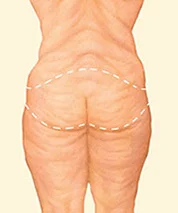
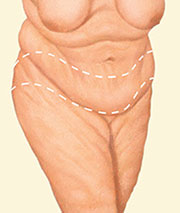
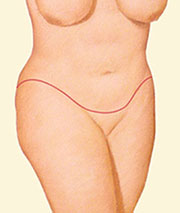
Lower Body Lift
A body lift is a surgical procedure that is designed to address excess skin and fat of the lower abdomen, back, lateral thighs, and pubic area. The operation addresses the laxity and deflation of the lower abdomen and lower back in patients that have undergone significant weight loss. For many individuals, significant laxity of the lateral thighs (saddle bag area), along with the lower abdomen and back, can be treated with a lower body lift. This operation uses similar incisions and surgical steps as a belt lipectomy. In contrast, the lower body lift can achieve additional lift along the lateral thighs through extra surgical steps that are not routinely part of the belt lipectomy.
Many patients who undergo significant weight loss, especially after bariatric surgery, develop significant changes to the appearance of their abdomen, trunk, and legs. The changes that occur can differ between individuals and are often dependent on a variety of factors. Some of these factors include the starting body mass index (BMI), degree of weight loss, time frame of the weight loss, genetic patterns of fat deposition, and degree of skin/soft tissue deflation among others. In a majority of patients, weight loss around the midsection occurs in a manner akin to an inverted cone. Loose skin and deflated soft tissue fall due to the pull of gravity and collects around the midsection, resulting in the “spare tire” that is troublesome to many patients. Although regular exercise has the ability to tone and strengthen the underlying muscle, it will not tighten loose skin that has been stretched over many years. A number of permanent structural changes occur in skin that has been stretched beyond in normal capacity to snap back. On a microscopic level the collagen and elastic fibers, which give skin its strength and elasticity, become fractured. Such loose skin can also be thought of as a pair of pants with an elastic waistband that has been permanently stretched. The only way for these pants to fit again is to tighten the loose waist band or the loose fabric. A body lift essentially tries to “take in” the suit of skin and soft tissue that overlies the body’s underlying skeleton and muscles for a leaner and “tighter” overall appearance.
The reshaping of the trunk occurs through a series of incisions that extend around the hips to the pubic areas anteriorly and surrounding the buttocks posteriorly. The following are some of the common issues following weight loss that are addressed by a body lift:
- A soft tissue flap of the lower abdomen that can hang over the belt line (a panniculus)
- A soft tissue roll of the lower back and hips
- Bulging and loss of contours of the lateral hips and upper thighs (saddle bags)
- Weakness of the abdominal wall
- Fullness of the soft tissue of the pubic area (mons pubis)
- Drooping of the buttocks
Body lifts are extensive surgical procedures that should only be performed by surgeons with experience in the recontouring of patients following major weight loss. Dr. Zemmel is an extensively trained plastic surgeon with experience in this specialty. One of the most important components in obtaining a good result is in careful pre-operative planning to outline a surgical treatment to address a patient’s unique concerns. Prior to surgery, a patient will undergo careful pre-surgical marking while standing. Occasionally this marking is done the day before surgery to allow for meticulous marking without time constraints. Once the patient is asleep from the anesthesia, surgery will proceed with the patient in the supine position. In this position, removal of excess abdominal skin, tightening of the underlying abdominal wall, and recontouring of the pubic area can occur. The patient is then placed on their side in order to remove the loose skin of the thighs and lower back and to tighten the buttocks. They are then rotated to address the opposite side. Numerous soft drainage tubes are placed deep to the incisions to collect any surgical fluid that may accumulate following surgery.
Healthy patients that have developed changes of the trunk and legs as a result of major weight loss are potential candidates for a body lift. In patients that have undergone major weight loss, there are a few specific areas that must be considered in determining whether a body lift is appropriate:
- Medical Status: Many of the medical conditions that are a byproduct of morbid obesity are frequently corrected or stabilized by major weight loss. In addition, patients that have undergone surgical weight loss will have specific nutritional requirements that necessitate maintenance for overall good health and to ensure proper wound healing. The ideal candidate for a body lift is medically stable and is following the medical and nutritional plan that has been outlined as a part of their bariatric surgical care.
- Psychological Status: The changes in body shape that occur following weight loss often can affect the way an individual feels about him or herself. The ideal candidate should be in a “good place” psychologically before proceeding with body lift surgery.
- Weight Loss Status: Patients should be at or within a reasonable range of their goal body weight for a minimum of one year before proceeding with surgery.
Surgery will take place in a local Richmond area hospital, in a fully accredited operating room. You will have a full team of operating room nurses, anesthesiologists, certified nurse anesthetists, and support personnel to ensure you receive the best surgical care possible. You will also be admitted to the hospital overnight for observation and safe keeping. You will have a private room and receive IV pain medicines, IV medicines for nausea if needed, and IV fluids. Dr. Zemmel believes this type of complex surgery should be performed in the hospital setting for your safety and to ensure your best outcome.
To minimize your risks for complications during surgery, our surgeon and the nurses will take special precautions. Once you are asleep, you will be positioned in such a way to prevent undue pressure on your skin. To keep you warm in surgery, special heating pads will be placed under you, and all IV fluids will be warmed. Special squeezing devices will be applied to your feet and calves to prevent the development of blood clots in the blood vessels of your legs.
Following your surgery, you will be admitted to the hospital for observation and pain control. You will be provided with round-the-clock nursing care to ensure patient safety and comfort. In addition to your home medications, you will receive medications to minimize discomfort and prevent blood clot formation. Shortly after surgery, you will be encouraged to get out of bed with assistance. Most patients are ready for discharge after about one to two days. Prior to discharge, you will be given instructions for home care of your surgical drains and for your scheduled follow-up appointment.
Shortly after surgery, you may initially have some difficulty getting out of bed. You might require some assistance in ambulating for the first few days. You may notice that you will need to walk with a slight bend at the waist for a few days. In time, you will be able to walk upright again. In most cases, surgical drainage tubes are removed within one week of surgery, although occasionally they will remain in place longer. You will likely be discharged from the hospital once your pain is controlled with oral medications, you are tolerating a diet, and you are voiding without difficulty.
Once at home, you will typically be able to resume light daily activities. You should refrain from vigorous exercise for at least three to four weeks, although you can resume walking as tolerated. You will have moderate swelling and some bruising following surgery. The initial bruising will typically resolve within two weeks; however, the tissue swelling may persist for several months after surgery. Scars often fade and flatten over time; however, the scar maturation process is slow and may take as long as 18 months to achieve its final appearance. Once your wounds are healed after two weeks, you may be prescribed a custom scar gel to minimize your scar post-operatively.
Although considerable efforts are taken to reduce their risk, complications can occur following body lift surgery. Potential complications of a body lift include bleeding, infection, delayed wound healing, unpredictable or undesirable permanent scarring, unexpected reaction to anesthesia, and blood clots in the legs or lungs. Some patients may develop numbness adjacent to the incisions that may take three to six months for resolution. In rare cases, the numbness is permanent. Given the unpredictable nature of the healing process, patients may require additional procedures to address persistent asymmetries or areas of residual soft tissue laxity. Occasionally, patients may develop fluid collections, called seromas, under the incisions that accumulate after the drains are removed. In most cases, these fluid collections can be drained with a simple office procedure.
Dr. Zemmel and his staff were excellent. They made me feel relaxed during a very difficult time in my life. It was reassuring to have a physician that knew exactly what I needed before I could ask. When I first met Dr. Zemmel in April of 2013, he said ‘do not worry, I am going to take great care of you’. He never fell short! He exceeded my expectations from our very first interaction. I will never hesitate to refer patients to Dr. Zemmel and his staff. He is everything a physician should be (and much more).
Leonora Johnson
December 13, 2013
Thigh Lift
Following major weight loss, some patients find that they have a significant amount of skin laxity of the inner and outer thighs resulting in a loss of a smooth thigh contour. At times, there can be multiple soft tissue rolls that hang over the inner portion of the knee. As a result of these physical changes, patients can be self-conscious wearing shorts or skirts. Functional issues including rashes and chafing of the skin may also be problematic.
Thigh lifting is most commonly performed on men and women who have undergone major weight loss surgery. It is particularly helpful in patients in whom liposuction alone is not sufficient to reshape the thighs. A medial thigh lift is a surgical procedure designed to address excess tissue in that specific area of the body.
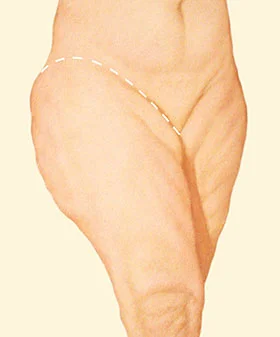
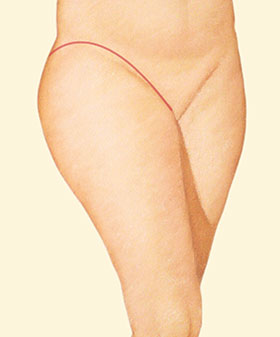
To recontour the thighs, a series of incisions are made to include the areas of loose skin. The types of incisions that are typically used can be dependent on the degree of soft tissue laxity. In most cases, this involves an incision from the inner aspect of the medial thigh that extends to the level of the knee. Because there is still persistent thigh fat present following weight loss, liposuction is frequently performed in conjunction with skin excision. In some cases, the incisions can be hidden in the crease of the groin of the thigh. Skin laxity involving the outer thighs (the saddle bag area) is typically addressed in circumferential body lifting procedures.
Healthy patients who have excess skin and fat of the upper and inner thighs may be good candidates for thigh lift surgery. Ideal patients have typically undergone significant weight loss and have been able to maintain their new weight for at least six months. To minimize the risk of potential complications, patients should not be active smokers for at least six weeks prior to and following surgery. All patients should be in good medical condition without significant cardiovascular, kidney, or lung disease. Smokers will be asked to quit smoking for a minimum of six weeks prior to surgery to minimize wound-healing complications.
On the morning of surgery, you will undergo the necessary pre-surgical markings to address the areas that were discussed in your pre-operative consultation. You will meet a board-certified anesthesiologist and nurse anesthetist, as well as our experienced intraoperative nursing staff who will care for you during surgery. After pre-surgical markings are performed, you will be taken to the operating room for surgery. Thigh lift surgery usually takes between two and three hours to perform; however, operative time may be longer if additional procedures are performed. You will also be admitted to the hospital overnight for observation and pain control. Dr. Zemmel believes admitting you overnight to the hospital improves your overall outcome. Your pain and potential nausea will be controlled with IV medicine and you will be well hydrated with IV fluids. Your safety and well-being are Dr. Zemmel’s primary concern and every effort will be made to care for you.
After surgery, you will notice that your legs will be wrapped in a light compression dressing. Soft drainage tubes will be placed deep to the incisions to collect any fluid that may accumulate after surgery. Your nurses will show you how to care for these drains. They are usually removed one week after surgery, depending on how much fluid is draining. You will be able to ambulate after surgery; however, you may initially need some assistance in getting out of bed. You will notice some post-operative swelling and bruising that usually resolves within one to two weeks, especially when adjunct liposuction is performed. Within the first two weeks of surgery, you will likely be placed in a compression garment of a spandex-like material, to assist in reduction of the swelling and in the recontouring of your thighs. Also, in the first few weeks following surgery, you will be asked to keep your legs elevated after periods of sitting or prolonged standing to help reduce post-operative swelling. Some patients may develop numbness along the incisions, which usually resolves within three to six months. Rarely, the numbness persists longer or remains permanent.
Your newly reshaped leg contours often become more evident as the swelling and bruising subsides. In most cases, you will see immediate and noticeable improvements which will continue to get better over time, typically up to six months after surgery.
Complications from a thigh lift may include bleeding, infection, long-term scarring, asymmetries, and wound healing complications. Fortunately, all of these occur rarely. Other potential rare complications include blood clots of either the legs or lungs that would require additional medical treatments. Occasionally, patients may develop fluid collections, called seromas, under the incisions that accumulate after the drains are removed. In most cases, these fluid collections can be drained with a simple office procedure. In the event that asymmetry between each leg persists, or recurrent loose skin occurs, additional procedures may be necessary.
As mentioned above, some patients may develop numbness along the inner aspect of the thigh. This numbness usually resolves within approximately six months of surgery; however, in limited cases, it may be permanent. Surgical excision of tissue adjacent to the groin crease can rarely cause long-term swelling of the leg called lymphedema. Fortunately, the techniques utilized by Dr. Zemmel can help minimize the likelihood of these difficult complications.
Does Insurance Cover Skin Removal After Major Weight Loss?
Insurance coverage for skin removal surgery after major weight loss can vary. Typically, if the surgery is deemed medically necessary—due to issues like rashes, infections, or other skin problems caused by excess skin—insurance may cover it. However, if the procedure is considered purely cosmetic, insurance is unlikely to cover the costs. It is important for patients to consult with their insurance provider to determine what is covered in their specific policy.
In addition to accepting insurance, we offer financing options at Richmond Aesthetic Surgery to help make aesthetic enhancements, both surgical and non-surgical, easier to budget and pay for. We have partnered with reputable financing companies to make it possible for qualified applicants to have access to flexible payment plans.
Contact Richmond Aesthetic Surgery
To learn more about body contouring procedures following weight loss or to schedule a consultation, please contact Richmond Aesthetic Surgery today for your consultation.